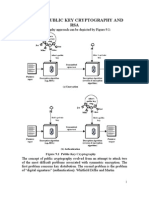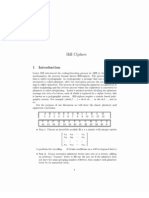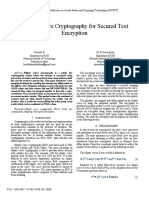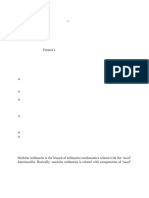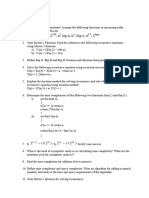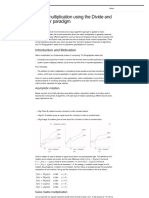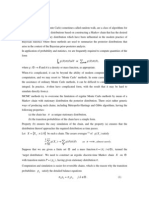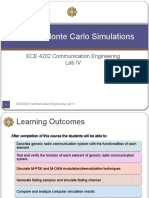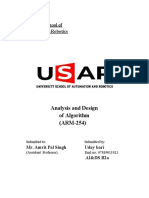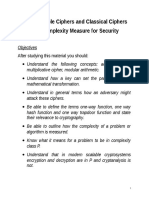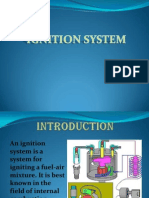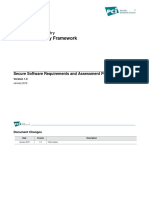Hill Chipper Algorithm
Uploaded by
Randy LeeHill Chipper Algorithm
Uploaded by
Randy LeeInternational Journal of Engineering Research & Technology (IJERT) ISSN: 2278-0181 Vol.
2 Issue 9, September - 2013
Hill Cipher algorithm with Self Repetitive Matrix for Secured Data Communication
1
Prof.Sana F Amin
1
Prof. Nilofar S Hunnergi
Assistant Professor Ashokrao Mane Group of Institutions, Vathar
2
Assistant Professor Sanjay bhokre college of engineering, Miraj
ABSTRACT The core of Hill-cipher is matrix manipulations It is a multi-letter cipher,for Decryption the inverse of matrix requires and Inverse of the matrix doesnt always exist. Then if the matrix is not invertible then encrypted text cannot be decrypted. However, a drawback of this algorithm is over come by use of self repetitive matrix.This matrix if multiplied with itself for a given mod value (i.e. mod value of the matrix is taken after every multiplication) will eventually result in an identity mat rix after N multiplications. So, after N+ 1 multiplication the matrix will repeat itself. Hence, it derives its name i.e. self repetitive matrix. It should be non singular square matrix. KEYWORDS- Cryptography , encryption, Decryption, Hill-cipher
1. INTRODUCTION Cryptography is defined as the science or study of the techniques of secret writing, esp. code and cipher systems, methods, and the like. Cryptography is needed so that
text can be kept secret. It is easy to imagine situations in ancient times where a writer who sent a message via courier would want to make sure that if the runner were intercepted, the interceptors could not read the message. Recently, the uses of cryptography have grown drastically. Becuase
advent of computers and with it the vast amount of information being shared on the internet, there has been a need to create better, more efficient encryption strategies to protect private information, such as credit card numbers, private communications, and so on.
IJE RT
IJERTV2IS90575
www.ijert.org
2960
International Journal of Engineering Research & Technology (IJERT) ISSN: 2278-0181 Vol. 2 Issue 9, September - 2013
2. PRESENT THEORY & PRACTICES HILL CIPHER It is a multi-letter cipher, developed by the mathematician Lester Hill in 1929.For encryption, algorithm takes m successive plaintext letters and instead of that substitutes m cipher letters. In Hill cipher each character is assigned a numerical value Like: a=0, b=1, .. .. z=25. The substitution of cipher text letters in place of plaintext leads to m linear equations. For m=3,
C1= (K11P1+K12P2+K13P3) MOD26 C2= (K21P1+K22P2+K23P3) MOD26 C3= (K31P1+K32P2+K33P3) MOD26 C=KP
This can be expressed in terms of column vectors and matrices:
Where C and P are column vectors of length 3, representing the plaintext and the cipher text and K is a 3*3 matrix, which is the encryption key. All operations are performed mod 26 here. Decryption requires the inverse of matrix K. The inverse K-1 of a matrix K is defined by the equation. K K-1= I where I is the Identity matrix. K-1 is applied to the cipher text, and then the plain text is recovered. In general terms we can write as follows: For encryption: C= Ek (P) = KP For decryption: P= Dk (C) =K-1 C= K-1KP=P
IJE RT
the system can be described as follows:
IJERTV2IS90575
www.ijert.org
2961
International Journal of Engineering Research & Technology (IJERT) ISSN: 2278-0181 Vol. 2 Issue 9, September - 2013
3. PROPOSED THEORY & PRACTICES Modification to the Algorithm As we have seen in Hill cipher decryption, it requires the inverse of a matrix. So while one problem arises that is: Inverse of the matrix doesnt always exist. Then if the matrix is not invertible then encrypted text cannot be decrypted. In order to overcome this problem we suggest the use of self repetitive matrix. This matrix if multiplied with itself for a given mod value (i.e. mod value of the matrix is taken after every multiplication) will eventually result in an identity matrix after N multiplications. So, after N+ 1 multiplication the matrix will repeat itself. Hence, it derives its name i.e. self repetitive matrix. It should be non singular square matrix. MODIFIED HILL CIPHER ALGORITHM: This algorithm generates the different key matrix for each block encryption instead of keeping
used for encrypting the plaintext, whether that is invertible or not. If the encryption matrix is not invertible, then the algorithm modifies the matrix such a way that its inverse exist. The new matrix we obtain after modification of key matrix is called as Encryption matrix and with the help of this matrix encryption operation is performed. In order to generate different key matrix each time, the encryption algorithm randomly generates the seed number and from this key matrix is generated. Key matrix, K K11 K12 K21 K13
K22 K23
K31 K23 K33 Where, K11 = seed number K12 = (seed number * m) mod n K13 = (12 K * m) mod n K21 = (13 K * m) mod n ..
IJE RT
the key matrix constant. This increases the secrecy of data. Also algorithm checks the matrix
IJERTV2IS90575
www.ijert.org
2962
International Journal of Engineering Research & Technology (IJERT) ISSN: 2278-0181 Vol. 2 Issue 9, September - 2013
K33 = (32 K * m) mod n Where m is successive numbers of plaintext letters taken at a time for encryption and n is length of the lookup table (total characters used for encryption and decryption) or we can set this n value as per requirement. Then with the help of key matrix, encryption matrix E is generated.
Steps for encryption matrix generation are as follows:
(1) Check whether the matrix K is invertible or not. (2) If inverse of matrix K does not exist, then adjust the diagonal elements (Increment the values of diagonal elements, one element at a time) so that the inverse of the resultant matrix (matrix
matrix E.
In this algorithm it takes m successive plaintext characters and substitutes for then m cipher text characters. The substitution is determined by m linear equations in which each character is assigned a numerical value (we can take the characters ASCII equivalent number or we can assign a lookup table like a = 0, b = 1 ... z = 25) Here for m = 3, the System can be described as follows: C1= (E11 P1+E12 P2+E13 P3) mod n C2= (E11 P1+E12 P2+E13 P3) mod n C3= (E11 P1+E12 P2+E13 P3) mod n This case can be expressed in term of column vectors and matrices: C1 C2 C3 = E11 E12 E1 E21 E22 E23 E31 E32 E33 P1 P2 P3 mod n
IJE RT
obtained after changing diagonal elements) is invertible. This matrix becomes the Encryption
IJERTV2IS90575
www.ijert.org
2963
International Journal of Engineering Research & Technology (IJERT) ISSN: 2278-0181 Vol. 2 Issue 9, September - 2013
or C = EP mod n , where C and P are column vectors of length 3 , representing the Cipher text and plaintext respectively, and E is a 3 3 encryption matrix. All operations are performed mod n.
Steps for Decryption Matrix:
For decryption, from the seed number once again similar way E matrix is generated. Decryption required using the modulo inverse of the matrix E. The inverse E-1 of matrix E is defined by the equation E.E1 = E1.E = I Where I is the matrix that is all zeros expect for ones along the main diagonal from upper left to lower right. Hence decryption matrix D is generated by doing modulo inverse of encryption matrix. Multiply decryption matrix D with received cipher text number vector C and then do modulo operation. Then operate on the output resultant vector, substitute its equivalent characters and which is the plaintext. We can explain this as Plaintext = P = D.C = E 1C. In general, the algorithm can be expressed as follows: Cipher text = C = EP mod n Plain text = P = E -1C mod n = E -1EP = P
Generation of a self repetitive Matrix A for a Given N:
The initial conditions for the existence of a self repetitive matrix are: 1.The matrix should be square. 2.It should be non-singular. But trying to find out the value of N (the value where the matrix becomes a identity matrix) through the method of brute force may not be the best idea always; because the matrix is of dimension greater than 5*5 and with mod index (i.e.) greater than 91 then the brute force technique might take very long time and N value may be in the range of millions. A normal Pentium 4 machine might hang if asked to do the computations for 15*15 matrixes or more. Hence, it would be comfortable to know the value of N and then generate a random matrix accordingly.
IJE RT
IJERTV2IS90575
www.ijert.org
2964
International Journal of Engineering Research & Technology (IJERT) ISSN: 2278-0181 Vol. 2 Issue 9, September - 2013
This can be done as follows: 1 .First a diagonal matrix A is chosen, and then the values powers of each individual element when they reach unity is calculated and denoted as n1, n2, n3.... Now LCM of these values is taken to given the value of N.
2.Now the next step is generate a random square matrix whose N value is same as the N calculated in the previous step. 3.Pick up any random invertible square matrix B 4.Generate C=B-1AB 5.The N value of C is also N Mathematical proof: (B-1AB)N= (B-1)N *(A)N*(B)N AN=I as calculated before as it is a diagonal matrix and N is the LCM of all elements (B-1B)*(B-1*B).......n times=I
4. RESULTS
Let us see the result with the case study for an array of 5 elements . Let, m = 5, n = 97 and Seed number S = 141 Then, K11 = 141 K22 = (K11*2) mod n .. .. K55 = (K44*5) mod n Hence Key Matrix:
K=
141 0 0 0 0
0 90 0 0 0
0 0 78 0 0
IJE RT
0 0 0 24 0 0 0 0 0 24
IJERTV2IS90575
www.ijert.org
2965
International Journal of Engineering Research & Technology (IJERT) ISSN: 2278-0181 Vol. 2 Issue 9, September - 2013
Consider the plaintext to be encrypted is event. Letters of the plaintext are represented by their equivalent number vector (30 47 30 39 45) ENCRYPTION MATRIX Then with the help of key matrix, encryption matrix is generated. Encryption matrix we get as 62 0 0 0 0 0 6 0 0 0 0 0 22 0 0 0 0 0 35 0 0 0 0 0 35
K=
Then, Cipher text for the plaintext is [17
88
78
23]
Decryption is done by doing inverse method of above and the cipher text is converted to the original as event
Decrypted Plain text output. Thus replacing the vector numbers (30 word event. 47 30 39 45) by their ASCII values we get the
Avalanche Effect: Here avalanche parameter is used to evaluate performance of the proposed system. The proposed system is built on Mat lab platform, Comparison of results performed between proposed algorithm and two existing algorithms. At the time of results evaluation, plain text and key value both were written randomly. To calculate total effect proposed system run so many times on
IJE RT
mod (97)
30 36 47 0 30 = 0 39 0 45 0
0 0 0 81 0 0 0 75 0 0 0 61 0 0 0
0 0 0 0 61
17 88 78 7 23
IJERTV2IS90575
www.ijert.org
2966
International Journal of Engineering Research & Technology (IJERT) ISSN: 2278-0181 Vol. 2 Issue 9, September - 2013
Different-different text file with the same key value and then final results were observed. Thus in the case of avalanche effect evaluation, after running proposed systems several times, the final results are the same i.e. in numeric form.
1. Avalanche Effect Comparisons: Avalanche Effect is the important property in cryptographic algorithms where, if an input is changed slightly (changing a single bit) the output changes significantly. In our case, we have chosen two different input plain text as welcometomycolle and welcometomycollewelcometomycolle Because of key length used in existing algorithm, proposed algorithm and A Block Cipher Having a Key on One Side of the Plain Text Matrix and its Inverse on the Other Side are using 128 bits key length where A Modified Hill Cipher Involving a Pair of Keys and a Permutation is using 256 bits key length. And proposed algorithm is using 56 bit key length.
a) A Block Cipher Having a Key on one side of the Plain Text Matrix and its Inverse on the other side Plain Text: welcometomycolle
000011000000111000001010101000100000010011000000000000001001100000001010001000 11010110000010100000000000011110000100000000000000 Change in Plain Text: welcometomycolla 000010000001010000010101010011000000000101010001000000000011000000001100010011 1011100000110100000000000001110000110000001000000 Avalanche Effect: 18
b) A Modified Hill Cipher Involving a Pair of Keys and a Permutation Plain Text: welcometomycollewelcometomycolle 000000000000000000000000000000000000000000000000000000000000100000000000000000 000000000000001000000000000110100000000000000000000010011000000000010100110000 000001010110000000000010000000100011010001100010000010000000011010000001011100 1010010111110010110010
IJE RT
IJERTV2IS90575
www.ijert.org
2967
International Journal of Engineering Research & Technology (IJERT) ISSN: 2278-0181 Vol. 2 Issue 9, September - 2013
Change in Plain Text: welcometomycollewelcometomycolla 100000010000001000000100000010000111000000000111000110000011100010100011000110 000001111100001001111111100110100000000000000000000010011000000000010100110110 000111010110000001111110000000111111010001100010110010111100011010011111011100 1011111111110010110010
C) Proposed Algorithm Plain Text: welcometomycollegewe 011000010101011001110011000100000000010101001001100100000001000101000000000101 011001000100010111000100000001010000110011010110000000010110000001010101000001 010000000000000000000000000000000000000000000000000000000000000000000000000000 00 Change in Plain Text: walcometomycollegewe 100000010010000100000100011100010100010001110010000101010001000100010001000101 010001001101100110000101000001000100100001010001100110000101000011100110010001 000110010101000101010100000101000000000000000000000000000000000000000000000000 000000000000000000000000000000 Avalanche Effect: 79 ENCRYPTION TECHNIQUE
A Modified Hill Cipher Involving a Pair of Keys and a Permutation 18 A Block Cipher Having a Key on One Side of the Plain Text Matrix and its 59 Inverse on the Other Side.
Proposed Algorithm
IJE RT
79
AVALANCHE EFFECT
IJERTV2IS90575
www.ijert.org
2968
International Journal of Engineering Research & Technology (IJERT) ISSN: 2278-0181 Vol. 2 Issue 9, September - 2013
90 80 70 60 50 40 30 20 10 0 A Modified Hill A block Cipher Proposed Algorithm 18 Avalanche Effect 59 79
X Axis -Selected Algorithms, Y Axis - Bit Difference Figure : Avalanche effect
5. CONCLUSION
This modified Hill Cipher method is easy to implement and difficult to crack. The cipher is considered secure, as it supports strong substitution techniques along with modular arithmetic. The block size which is specified as 64 bit is expandable as per requirement, thus gives flexibility in message string length. Possible ASCII printable character keys are 957 and key combinations are 256. As per our findings time required checking all possible keys at 50 billion keys per second for a 56 bit key: would approximately be 400 days. o The above performance will be appropriate for the following kind of applications 1) In ATMs for pin numbers to maintain its secrecy and security of ATM card.
IJE RT
IJERTV2IS90575
www.ijert.org
2969
International Journal of Engineering Research & Technology (IJERT) ISSN: 2278-0181 Vol. 2 Issue 9, September - 2013
2) In Email applications for military and civilian purpose where security is of prime importance in terms of records and authentication of messages. 3) In SMS services, e-commerce, pay TV, computer passwords and touches many aspects of our daily lives.
REFERENCES 1. Blakley, G.R.; Twenty years of cryptography in the open literature Security and Privacy, 1999. Proceedings of the 1999 IEEE Symposium on Digital Object Identifier: 10.1109/SECPRI.1999.766903 2. Secure Hill cipher modifications and key exchange protocol ,Mahmoud, Ahmed Y.; Chefranov, Alexander G.; Automation Quality and Testing Robotics (AQTR), 2010 IEEE International Conference on Volume: 2 Digital Object Identifier.
V.; Kuznetsov, A.; Information Technology: New Generations, 2009. ITNG '09. Sixth International Conference on ,Digital Object Identifier: Publication Year: 2009 , Publication Year: 2010
4. A secure variant of the Hill Cipher ,Toorani, M.; Falahati, A.; on, Digital Object Identifier: 10.1109/ISCC.2009.5202241 ,Publication Year: 2009. 5. Invertible, Involutory and Permutation Matrix Generation Methods for Hill Cipher System ,Acharya, B.; Jena, D.; Patra, S.K.; Panda, G.; Advanced Computer Control, 2009. ICACC '09. International Conference on ,Digital Object Identifier: Publication Year: 2009. 6. Bruce Schneir: Applied Cryptography, 2nd edition, John Wiley & Sons, 1996 7. 8. Piper,F Encryption. Security and Detection, Ecos 97. European Conference; Abrams, M., and Podell, H. Cryptography Potentials, IEEE Page No 36-38. Issue:1,Volume: 20, Feb-Mar,2001 9. Eskiciogiu,A. Litwin,L Cryptography and Network Security LOS Alamito s,CA:IEEE computer society press,1987 10. Garfinkel, S.L; Public Key Cryptography , Computer, IEEE, Volume: 29, Issue:6, June 1996.
IJE RT
3.
The Design of Boolean Functions by Modified Hill Climbing Method ,Izbenko, Y.; Kovtun,
IJERTV2IS90575
www.ijert.org
2970
International Journal of Engineering Research & Technology (IJERT) ISSN: 2278-0181 Vol. 2 Issue 9, September - 2013
11. W.Diffie; M.E.Hell man, New Directions in Cryptography IEEE Transactions Information Theory, Nov, pp 644-654 12. E.Biham and A.Shmir; Differential C for Cryptanalysis of the Encryption Standard; Springer- Verilag,1993
IJE RT
IJERTV2IS90575
www.ijert.org
2971
You might also like
- Introduction To Modern Cryptography - 2nd Edition Solutions Manual50% (6)Introduction To Modern Cryptography - 2nd Edition Solutions Manual156 pages
- Information Systems Security LAB: RSA Cryptography AlgorithmNo ratings yetInformation Systems Security LAB: RSA Cryptography Algorithm9 pages
- Image Encryption Using Advanced Hill Cipher AlgorithmNo ratings yetImage Encryption Using Advanced Hill Cipher Algorithm5 pages
- Chapter 9. Public Key Cryptography and RSANo ratings yetChapter 9. Public Key Cryptography and RSA8 pages
- Encryption Using Lester Hill Cipher Algorithm: Thangarasu.N DR - Arul Lawrence SelvakumarNo ratings yetEncryption Using Lester Hill Cipher Algorithm: Thangarasu.N DR - Arul Lawrence Selvakumar5 pages
- Asynchronous vs. Synchronous Design of RSA: AbstractNo ratings yetAsynchronous vs. Synchronous Design of RSA: Abstract6 pages
- Modulation Doping For Iterative Demapping of Bit-Interleaved Coded ModulationNo ratings yetModulation Doping For Iterative Demapping of Bit-Interleaved Coded Modulation3 pages
- FPGA Implementation of RSA Encryption System: Sushanta Kumar Sahu Manoranjan PradhanNo ratings yetFPGA Implementation of RSA Encryption System: Sushanta Kumar Sahu Manoranjan Pradhan3 pages
- Efficient Digital Encryption Algorithm Based On Matrix Scrambling TechniqueNo ratings yetEfficient Digital Encryption Algorithm Based On Matrix Scrambling Technique12 pages
- A Study of Matrices and Number Theory in Cryptography(Project)No ratings yetA Study of Matrices and Number Theory in Cryptography(Project)36 pages
- Aes Algorithm Using Modified Redundant Representation: Volume 2, Issue 2, March - April 2013No ratings yetAes Algorithm Using Modified Redundant Representation: Volume 2, Issue 2, March - April 20135 pages
- Rivest1985 Chapter RSAChipsPastPresentFutureExtenNo ratings yetRivest1985 Chapter RSAChipsPastPresentFutureExten7 pages
- Third Year: Practical Work Book For The Course EE-393 Digital Signal ProcessingNo ratings yetThird Year: Practical Work Book For The Course EE-393 Digital Signal Processing44 pages
- ECEG-6530 Computer (And Network) Security: RSA, Generating Random Numbers, EL Gamal Encryption, Hybrid EncryptionNo ratings yetECEG-6530 Computer (And Network) Security: RSA, Generating Random Numbers, EL Gamal Encryption, Hybrid Encryption50 pages
- Lecture 8: RSA Algorithm: A. Modular AdditionNo ratings yetLecture 8: RSA Algorithm: A. Modular Addition5 pages
- Abstract-A Novel Fault Attack Against ECDSA Is ProposedNo ratings yetAbstract-A Novel Fault Attack Against ECDSA Is Proposed6 pages
- Linear Cryptanalysis Method for DES CipherNo ratings yetLinear Cryptanalysis Method for DES Cipher12 pages
- mersenne_twister_pseudo_random_number_generatorNo ratings yetmersenne_twister_pseudo_random_number_generator11 pages
- An Advanced Hybrid Technique For Digital Signature Scheme: Hassan M. Elkamchouchi Ali E. TakieldeenNo ratings yetAn Advanced Hybrid Technique For Digital Signature Scheme: Hassan M. Elkamchouchi Ali E. Takieldeen5 pages
- Comparison of Various System Identification Methods For A MISO SystemNo ratings yetComparison of Various System Identification Methods For A MISO System16 pages
- Simplified Optimal Parenthesization Scheme For Matrix Chain Multiplication Problem Using Bottom-Up Practice in 2-Tree StructureNo ratings yetSimplified Optimal Parenthesization Scheme For Matrix Chain Multiplication Problem Using Bottom-Up Practice in 2-Tree Structure6 pages
- Digital Signal and Image Processing using MATLAB, Volume 3: Advances and Applications, The Stochastic CaseFrom EverandDigital Signal and Image Processing using MATLAB, Volume 3: Advances and Applications, The Stochastic Case3/5 (1)
- New Directions in Wireless Communications Systems - From Mobile To 5G (PDFDrive) PDFNo ratings yetNew Directions in Wireless Communications Systems - From Mobile To 5G (PDFDrive) PDF563 pages
- GATE Previous Year Solved Papers Mechanical PDFNo ratings yetGATE Previous Year Solved Papers Mechanical PDF229 pages
- Experiment No. 1: Pressure Intensity (Pressure)No ratings yetExperiment No. 1: Pressure Intensity (Pressure)44 pages
- Application of Design Space Approach To Solar Water Heating Systems With Pressurized StorageNo ratings yetApplication of Design Space Approach To Solar Water Heating Systems With Pressurized Storage6 pages
- INE-Lateral-Movement-and-Pivoting-Course-FileNo ratings yetINE-Lateral-Movement-and-Pivoting-Course-File107 pages
- Webinar - 04 - TDE Live Implementation On 19c RACNo ratings yetWebinar - 04 - TDE Live Implementation On 19c RAC14 pages
- Image Authentication Based On Watermarking ApproachNo ratings yetImage Authentication Based On Watermarking Approach4 pages
- ISO 27001 Statement of Applicability TemplateNo ratings yetISO 27001 Statement of Applicability Template6 pages
- Certified Network Security Specialist CNSS Questions0% (1)Certified Network Security Specialist CNSS Questions14 pages
- Synopsis On Encryption Using Rsa AlgorithmNo ratings yetSynopsis On Encryption Using Rsa Algorithm19 pages
- Key Words and Phrases. AES, Galois Field, Field Generator, Multiplication in GF (2No ratings yetKey Words and Phrases. AES, Galois Field, Field Generator, Multiplication in GF (214 pages
- That One Privacy Guy's VPN Comparison ChartNo ratings yetThat One Privacy Guy's VPN Comparison Chart50 pages
- Enterprise Networking, Security, and Automation - IPsecNo ratings yetEnterprise Networking, Security, and Automation - IPsec7 pages
- Opacity Secure Channel: Globalplatform Card - Amendment GNo ratings yetOpacity Secure Channel: Globalplatform Card - Amendment G50 pages
- Information Security Lecture Notes: Bachelor of Technology Information TechnologyNo ratings yetInformation Security Lecture Notes: Bachelor of Technology Information Technology107 pages
- Introduction To Modern Cryptography - 2nd Edition Solutions ManualIntroduction To Modern Cryptography - 2nd Edition Solutions Manual
- Information Systems Security LAB: RSA Cryptography AlgorithmInformation Systems Security LAB: RSA Cryptography Algorithm
- Image Encryption Using Advanced Hill Cipher AlgorithmImage Encryption Using Advanced Hill Cipher Algorithm
- Encryption Using Lester Hill Cipher Algorithm: Thangarasu.N DR - Arul Lawrence SelvakumarEncryption Using Lester Hill Cipher Algorithm: Thangarasu.N DR - Arul Lawrence Selvakumar
- Asynchronous vs. Synchronous Design of RSA: AbstractAsynchronous vs. Synchronous Design of RSA: Abstract
- Modulation Doping For Iterative Demapping of Bit-Interleaved Coded ModulationModulation Doping For Iterative Demapping of Bit-Interleaved Coded Modulation
- FPGA Implementation of RSA Encryption System: Sushanta Kumar Sahu Manoranjan PradhanFPGA Implementation of RSA Encryption System: Sushanta Kumar Sahu Manoranjan Pradhan
- Efficient Digital Encryption Algorithm Based On Matrix Scrambling TechniqueEfficient Digital Encryption Algorithm Based On Matrix Scrambling Technique
- A Study of Matrices and Number Theory in Cryptography(Project)A Study of Matrices and Number Theory in Cryptography(Project)
- Aes Algorithm Using Modified Redundant Representation: Volume 2, Issue 2, March - April 2013Aes Algorithm Using Modified Redundant Representation: Volume 2, Issue 2, March - April 2013
- Third Year: Practical Work Book For The Course EE-393 Digital Signal ProcessingThird Year: Practical Work Book For The Course EE-393 Digital Signal Processing
- ECEG-6530 Computer (And Network) Security: RSA, Generating Random Numbers, EL Gamal Encryption, Hybrid EncryptionECEG-6530 Computer (And Network) Security: RSA, Generating Random Numbers, EL Gamal Encryption, Hybrid Encryption
- Abstract-A Novel Fault Attack Against ECDSA Is ProposedAbstract-A Novel Fault Attack Against ECDSA Is Proposed
- An Advanced Hybrid Technique For Digital Signature Scheme: Hassan M. Elkamchouchi Ali E. TakieldeenAn Advanced Hybrid Technique For Digital Signature Scheme: Hassan M. Elkamchouchi Ali E. Takieldeen
- Comparison of Various System Identification Methods For A MISO SystemComparison of Various System Identification Methods For A MISO System
- Simplified Optimal Parenthesization Scheme For Matrix Chain Multiplication Problem Using Bottom-Up Practice in 2-Tree StructureSimplified Optimal Parenthesization Scheme For Matrix Chain Multiplication Problem Using Bottom-Up Practice in 2-Tree Structure
- Basic Exercises for Competitive Programming: PythonFrom EverandBasic Exercises for Competitive Programming: Python
- Digital Signal and Image Processing using MATLAB, Volume 3: Advances and Applications, The Stochastic CaseFrom EverandDigital Signal and Image Processing using MATLAB, Volume 3: Advances and Applications, The Stochastic Case
- New Directions in Wireless Communications Systems - From Mobile To 5G (PDFDrive) PDFNew Directions in Wireless Communications Systems - From Mobile To 5G (PDFDrive) PDF
- Application of Design Space Approach To Solar Water Heating Systems With Pressurized StorageApplication of Design Space Approach To Solar Water Heating Systems With Pressurized Storage
- Image Authentication Based On Watermarking ApproachImage Authentication Based On Watermarking Approach
- Certified Network Security Specialist CNSS QuestionsCertified Network Security Specialist CNSS Questions
- Key Words and Phrases. AES, Galois Field, Field Generator, Multiplication in GF (2Key Words and Phrases. AES, Galois Field, Field Generator, Multiplication in GF (2
- Enterprise Networking, Security, and Automation - IPsecEnterprise Networking, Security, and Automation - IPsec
- Opacity Secure Channel: Globalplatform Card - Amendment GOpacity Secure Channel: Globalplatform Card - Amendment G
- Information Security Lecture Notes: Bachelor of Technology Information TechnologyInformation Security Lecture Notes: Bachelor of Technology Information Technology








